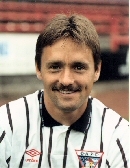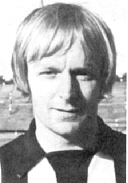DAFC Dream Team Centre Halves
Date: Sunday, 3rd Apr 2005In association with the matchday programme, we are asking you to record your votes for you favourites players. From your votes, the team that is deemed the greatest will be immortalised in a Dream Team limited edition print. One copy of this print will be given away free in a competition.
VOTING HAS NOW CLOSED
Over the years there have been many popular centre halves at East End Park and there’s no doubt that the fans have preferred the type of defender that liked to get stuck in. There is no shortage of suitable candidates to fill that particular role - the only question is who will be selected to line up alongside NORRIE MCCATHIE, a certainty to be chosen for the ‘Dream Team’. In what transpired to be a superb piece of business, Norrie signed for the Pars on 10th August 1981 from Cowdenbeath in an exchange for Craig McFarlane. A decent enough midfielder, it wasn’t until Jim Leishman moved him back into defence that Norrie became a legend. His ability to read the game was second to none; he was an excellent penalty box tackler and became the epitome of the inspirational captain. Playing under six different managers, he went on to make a club record 563 appearances for the Pars, scoring 54 goals. Norrie died tragically on 7th January 1996 but his loyalty to the club and to the town has earned him the undying love of the Dunfermline supporters.
John was one of the most popular players at East End during the latter half of the 1970’s. A strong player who was good in the air and on the deck, John frequently delighted the fans (and demented Harry Melrose) with his mazy runs out of defence. He joined the Pars in 1976 from Queen of the South and was an automatic choice for the next three seasons as the club finally gained promotion. From then on he was plagued by niggling injuries that limited his appearances to 160.

One of the true legends of the Sixties was ROY BARRY, a tough tackling, no-nonsense defender who had the heart of a lion. An inspiration to teammates and fans alike, Roy led the club to their Scottish Cup success of 1968 and then on to the semis of the Cup-Winners Cup the year after. Signed as an inside forward from Hearts in 1966, it was, like Norrie McCathie, only when he dropped back to defence that his true quality was discovered. He considered himself a target for referees in Scotland and this led to his transfer to Coventry for £45,000 in October 1969. He later played for Crystal Palace, Hibernian and East Fife, but without doubt his greatest days were with Dunfermline. The Pars too found Roy Barry impossible to replace and were never the same again.

The perfect foil for Barry in the Athletic defence was JIM FRASER, an intelligent player who would sweep up anything that came his way. He made his home debut against Celtic a few days after the 1965 Cup Final and was handed the task of marking big John Hughes. Despite still being a teenager, Jim marked Hughes out of the game and helped the Pars to a 5-1 win. Three years later Dunfermline recorded another memorable win over Celtic, this time in the Cup, but it was marred by a shocking challenge by Auld that broke Jim’s leg. He returned to play in both semi-final matches against St. Johnstone but was controversially omitted from the Cup Final line-up. In total Jim played 190 times for the Athletic, a figure which would have been much higher but for injuries, and most of these was as part of the greatest Pars defence ever, along with Callaghan, Lunn and Barry. Sadly, after a long fight with cancer, Jim passed away on March 20th 2002, aged 55.

Jock Stein made many valuable signings during his time at East End and one of his shrewdest was that of JIM MCLEAN from Ayr United in March 1962. Known as ‘Iron Man’, Jim was one of the hardest and most feared centre-halves in the country and his ‘never-say-die’ attitude inspired the rest of the team. He wasn’t the tallest defender but, like Roy Barry, had tremendous spring and dominated opposing forwards. Jim captained the Pars during 1964/65 when they came close to the League and Cup double but within a couple of years he was struggling with a persistent groin injury. In December 1966 the fans were shocked to hear that he had been told to stop playing immediately by medical experts. He had made over 200 appearances for Dunfermline and was a credit to the club both on and off the field.
Kenny never missed a match for five years - a remarkable run of 227 appearances. A local lad, Kenny had been one of the products of the Dunfermline youth development system when he broke through to first team football in 1970. A versatile player who was comfortable in several positions, it was perhaps as a sweeper that Kenny was seen at his best. Kenny’s lightning pace made him ideally suited to the position and he became the fastest professional footballer in Scotland. With 432 first team appearances, Kenny still holds the record for the second highest number of appearances in the club’s history.
views: 13,198
